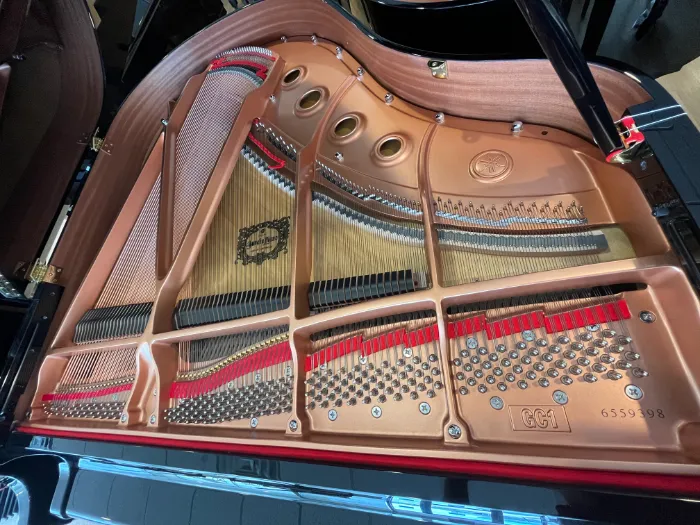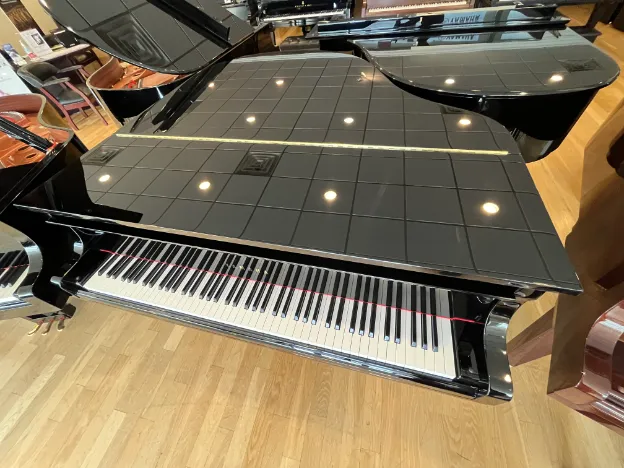GC1 vs GB1K Yamaha Baby Grand Acoustic Piano: Review 2025

As you may know from my GB1K Review, I am a piano tuner and technician who works with brand new Yamaha pianos.
My recommendation is that a GC1 is worth the extra money if you are interested in a base-line high quality baby grand piano.
I emphasize that the action of the keys and superior tuning stability is what sets this piano apart from a GB1K.
Take a look at my other options by reading my article below.
GC1 Technical Review
*All photos in this article are of a GC1.
Here is a brand new GC1 with a closed lid.
How large is a GC1?
The piano is 5 feet 3 inches long, which is 3 inches larger than the GB1K.
These photos help demonstrate the general size of the instrument as well as the overall shape of the furniture parts.
The case is completely closed.
Does Yamaha make their own action parts?
As you can see, the action has Yamaha's name on it because it is an action designed by Yamaha engineers.
I believe that this action is superior to the GB1K, and should be discernible to those who are at least intermediate piano players.
The difference in the playability is palpable. Complex piano pieces are better accessible when playing on the action of this piano.
Where is the Yamaha GC1 built?
On key C8, you can see the imprinted GC1 marking made during manufacturing at the piano factory in Hamamatsu, Japan.
On the left hand side of the furniture you can see this label that shows where this piano was manufactured.
Unlike the GB1K which are manufactured in Jakarta, Indonesia, GC1’s are manufactured in Japan.
With the fall board over the keys removed, you can view into the action of the piano.
When tuning, I take time to admire the colors of the inside of the rim, the pristine condition of the bridge, strings, and plate.
Do GC1's go out of tune quickly?
I also enjoy tuning the piano because it has better tuning stability long periods of time. For this reason alone, I would invest in a GC1!
I know that these pianos go out of tune less quickly, which is another major reason I prefer starting with GC1's when beginning to compare baby grand pianos.
Does Yamaha use composite piano parts?
The back action uses composite parts which is consistent with superior models.
Having composite parts at this part of the action reduces the likelihood that it will need to be replaced.
As a technician, I am relieved to see composite parts in this location because I know how challenging it can be to replace parts in the “belly” of the piano.
From my perspective, it is a relief to see this and provides peace of mind so that it is much less likely that I will ever have to replace on of these parts.
This is one of my favorite angles to take a photo as a technician on the inside of a piano.
While viewing the back action it is also a view over the pristine soundboard, underneath the strings, and down to the bridge.
It provides a glimpse of the “guts”/mechanical components of a baby grand piano beyond the nice-looking furniture.
How much is a Yamaha GB1K vs GC1?
Email my Colleague for direct pricing: Peter Creighton Email
Peter Creighton
Need a cheat sheet for negotiating price? See the Piano Buyer Book on Amazon
Read: My Review of the Piano Buyer Book
Save thousands of dollars with this $20 book.
What does a piano soundboard look like?
Behold. A view peering into the underside of the strings of the piano.
What does a piano pinblock look like?
Below, the pinblock is flush to the stretcher (the black finished flat piece) which is a critical component when evaluating the condition of a piano.
Keep in mind, that this piano is brand new, so there's no chance of this issue. Especially, since Yamaha's production is consistent and state-of-the-art.
What does the keybed look like?
Here is a picture of the key bed that evenly supports the key frame providing the foundational support to the keys.
The hardened circular wooden dowels are inlayed into the keybed so that the action can be as sturdy as possible when the glide bolts (which supports the piano key action) of the key frame meet the key bed.
The key bed is neat and clean, made up of hardwood that doesn’t scrape easily, unlike much older pianos of the trade.
In my view, the action looks pristine, which makes concert preparation easily manageable.
How do the keys feel on a GC1?
Something important to note is that the hammers are slightly longer than on a GB1K, which changes both the weight and feeling of inertia experienced when striking a key.
The wooden hammers are "reinforced."
Although specific measurements and particularities remain a Yamaha trade secret, I believe the feel of the keys are the most profound difference between the GC1 and GB1K other than tuning stability and tonality.
The action is removed to reveal how large and substantial the wooden components are.
Does a GC1 need to be prepped?
Concert prep is recommended for any brand new piano. Yamaha's are strikingly consistent which means it will take less time to render the results of a concert-ready instrument.
Easily adjustable and reliable rods are what I like about working on Yamaha trapwork/lyres. With other brands, in some cases trapwork/lyres can be a pain to work on.
The use of leather punchings is a nice touch. Generally there is a washer that sits in between the nut and the top of the rod which can cause noise if not properly tightened. Here, the leather will absorb extra noise if it's loose.
What does the soundboard of a GC1 look like?
I've known Yamaha to produce pristine soundboards. Here is an example of the 9 ribs included which help support the soundboard to maintain consistent sound impedance across the soundboard.
Yamaha GC1 lyre image
The lyre is simple, stable, and silent.
The aesthetic is classically elegant.
This angle shows you a little bit more of the character of this piano and what you can expect to see when visiting a piano showroom.
Yamaha GC1 tuning pins
I see the piano from this angle when I tune. Just looking at this I know that the pins will feel tight on this GC1, which is a preferred positive attribute.
The bushings surrounding the pins, in my opinion, allow the strings to render quickly which makes it easier and quicker to tune.
Here the photograph captures overlooking the bridge as well as the soundboard to get the full picture of the "harp."
For reasons I am unaware of, the GC1 requires less tunings than it's GB1K competitor, however I surmise to say that it is due to the treatment of the wood. In all fairness, this is speculation only.
I hope you enjoyed my article. Please let me know if you have questions.




















